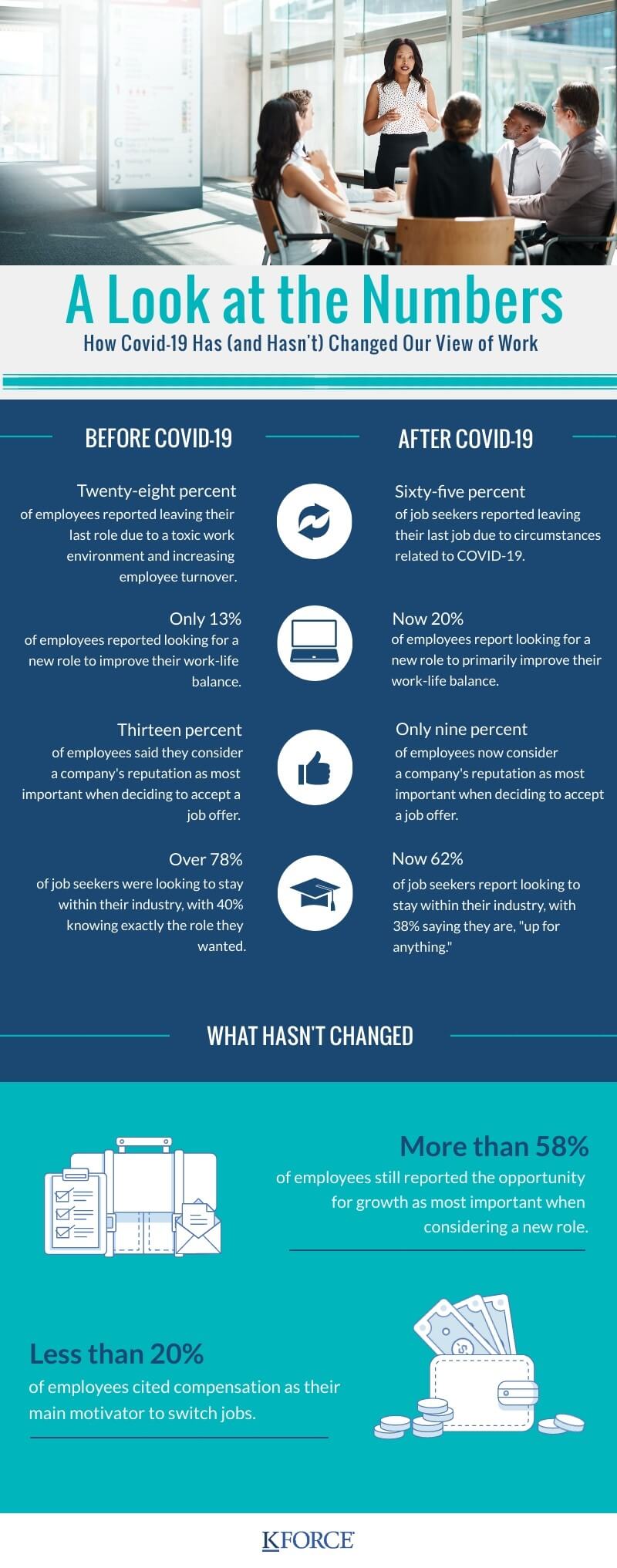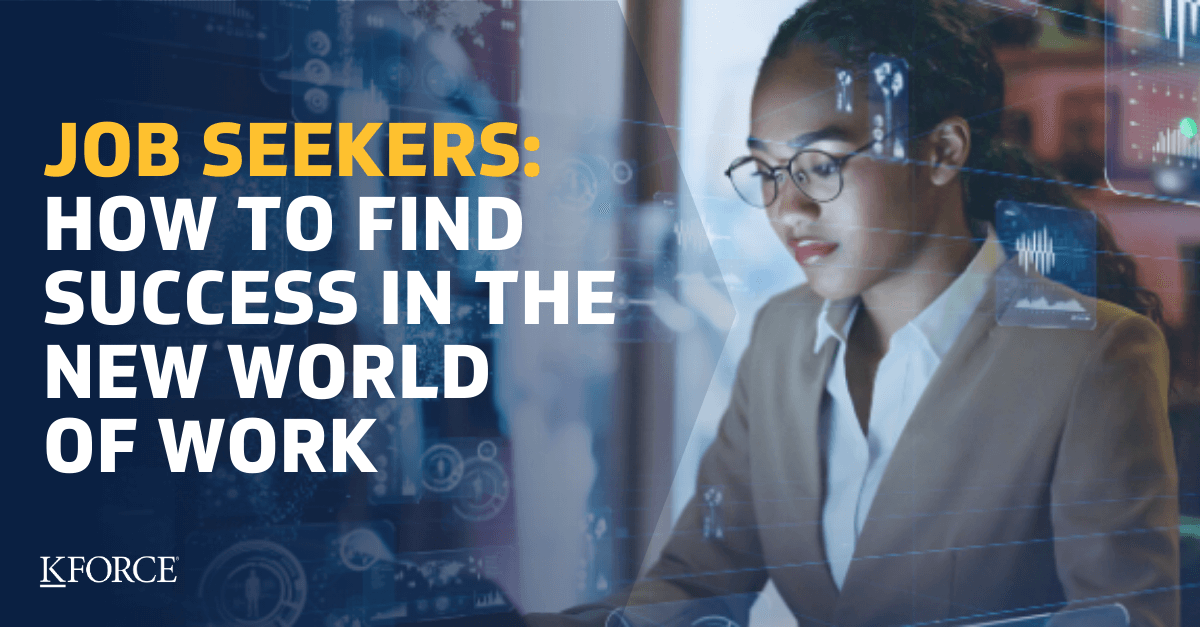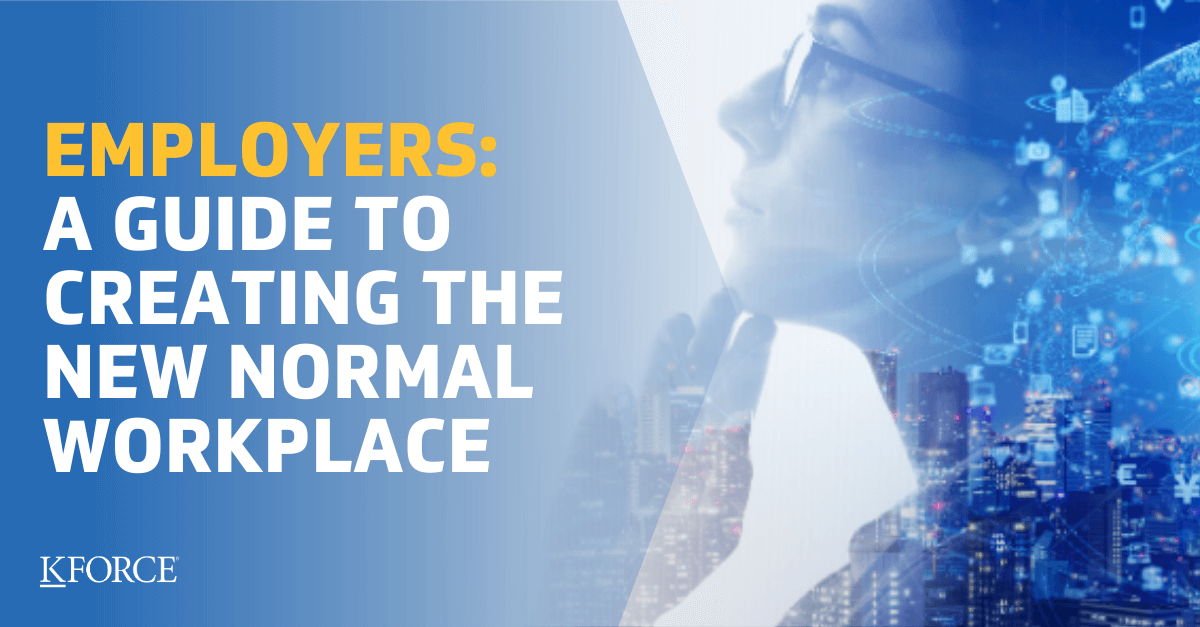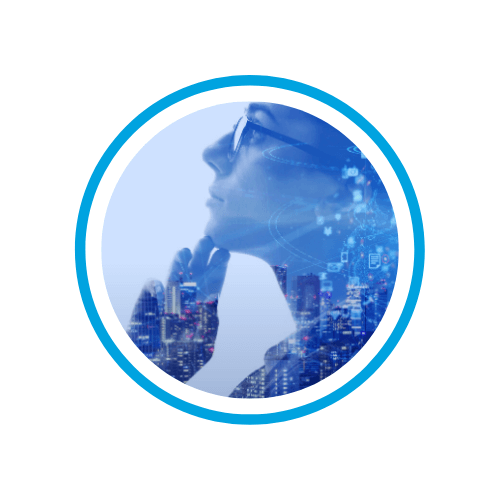Future of Work
How to Find Success in the New World of Work

Past Lessons for Success in the Future
If you’re wondering how changes made in response to COVID-19 will continue to impact the workplace after the effects of the virus have eased, you’re not alone. As many US workers come to terms with remote work extending until at least the first quarter of 2021, employees, job seekers and businesses are now thinking about what lasting impacts the pandemic will have on the workplace and what they can do now to adjust and prepare for success in the future.
With the number of open jobs slowly rising, new unemployment claims falling below pandemic-highs and jobseekers gaining more traction with their applications, we are moving closer to truly defining what the “new normal” will look like in both our personal and professional lives.
Our team of experts, backed by over 50 years of experience within talent acquisition and business solutions, have successfully guided our firm through varying market conditions and economic downturns. Now, they are ready to weigh-in on what we can expect to see in the future of work, as well as what both employers and employees can do now, as we all move together toward tomorrow®.
But before we can analyze the talent market of today and make data-driven predictions for tomorrow, Kforce has compiled survey data from before COVID-19 (Jun. 2019) with new data we recently gathered (Oct. 2020) to understand how our view of the workplace and workforce has changed amid the pandemic.


Understanding the Numbers
The most glaring, but unsurprising, difference between the pre-and-post-COVID-19 data is that 65% of job seekers reported leaving their last position due to COVID-19 related circumstances. Considering such a disturbance in the market, it’s no wonder why our views of the workplace and workforce has changed. With a 10% increase of job seekers looking for a better work-life balance and a 17% increase of employees reporting they would be “up for anything,” even an opportunity outside of their current industry or role, both job seekers and employees are redefining what the future of work looks like.
However, not everything has changed. Over 58% of employees still consider the opportunity for growth as the most important factor when looking at a new job, and less than 20% of employees report compensation as their main motivator for accepting a job offer. With a majority of job seekers looking for better growth opportunities instead of higher compensation, employers will still need to focus on internal development in our new digital workspace to attract and retain top talent.
While we continue to work through defining our current and future digital workforce amid the pandemic, our experts at Kforce are here to help you – whether that is assisting with your current job search or talent search now, or helping you better prepare for the future of work – as we move together toward tomorrow®.


Building a Career by Embracing Change
While there’s no denying our current situation has brought unprecedented challenges, we are also experiencing an exciting, historic shift to the working world—one full of innovation and opportunity. At the onset of the pandemic, the percentage of people working from home five days or more per week more than doubled. A study by McKinsey found that we vaulted five years forward in consumer and business digital adoption in just eight weeks. While much remains unknown about the future, one thing is becoming increasingly clear: staying agile and embracing technology will be our greatest assets in this growing virtual world.
Meeting the challenges of this moment with the willingness to explore new ways of working, learning and connecting will lead us successfully into the future. Whether you’re seeking a new opportunity or looking to grow in your current role, here’s what you need to know to thrive in this new world of work.

Evaluating Our Shifting Priorities and Practices
With meetings now taking place from kitchen tables rather than conference rooms and phone calls juggled in between sessions of virtual learning, we have had to modify many of the professional norms we once knew. As our work practices have shifted, so have our priorities.
According to Letitia Murray, Vice President of Delivery at Kforce, one of the most significant changes in employee and job seeker needs as we adapt to a largely remote workforce has been the transition away from the typical nine-to-five schedule.
“People are prioritizing flexibility more than ever before,” says Murray. “So many of us have suddenly become educators for our children or caregivers for relatives – we need those open scheduling options to continue to function successfully in our roles.”
53 percent of remote workers in the United States named flexible scheduling as the primary benefit of the work-from-home environment.
— A 2020 survey conducted by Statista
As a result of this shift, we’re seeing work/life balance morph into work/life fluidity. “Personal life and professional life are colliding right now,” says Jessica Schwaller, Senior Director of Associate Performance and Development at Kforce. “People may call it “the new normal,” but let’s be honest – nothing about this feels normal.”
Going forward, organizations should be cognizant of this rising need for flexibility and prepare to adapt their practices, whether that’s normalizing non-traditional hours, reinforcing protected breaks, or implementing mobile collaboration tools to keep employees connected.
Another major influence on job seekers’ motivations has been the disruption to the job market, as the economic impacts of the pandemic have resulted in widespread layoffs and hiring freezes. A survey conducted by Kforce found that 65% of current job seekers left their previous roles due to circumstances related to COVID-19. Schwaller notes that as a result of this phenomenon, job security is becoming increasingly important to today’s workforce: “In this climate, people are likely to value stability over other factors they previously prioritized.”
The market’s current unpredictability has not only impacted what qualities job seekers look for in a role, but also their overall career trajectory. Data collected by CareerUp program Remote Internships suggests that 30 percent of college students plan to change their career path due to the impacts of the COVID-19 pandemic, and a Kforce survey found that 38% of job seekers reported being open to any type of role, regardless of industry/position, in comparison to 21% of responses making the same claim in 2019. However, Murray acknowledges that while people may be choosing roles based on factors like financial security rather than passion or industry experience, there will still be plenty of opportunities to pursue meaningful careers.
“We are all undergoing a collective human experience right now,” says Murray. “Hiring managers will understand and respect demonstrated efforts to continue professional growth, even if your career path deviates from what you originally imagined.”
Schwaller agrees, remarking that we are seeing greater emotional competency in the workforce as a result of our current circumstances: “Factors like empathy and compassion are coming to the forefront. In this socially distanced environment, that sense of connection is proving more valuable than ever.”
Coping With a Rapidly Changing World
Change is an important element of a dynamic, thriving working world. But what happens when change is no longer a choice, but a necessity?
“These circumstances forced our hand in gaining efficiency and taught us that we can adapt and move in more agile ways,” says Schwaller. “We saw nearly every industry accelerate automation, digitization and innovation in a very short period.”
Even positive change can be difficult to cope with, especially when it happens at an expedited pace. While it will take time to find our footing in this new world of work, Schwaller offers her advice on how we can find balance and stay connected.
Maintaining successful communication is key. Staying aligned on goals and objectives is always valuable, but even more so now when we need to remain connected from a distance.
“A lot of times, we assume that our leaders are making sure they’ve defined clear expectations, but it goes both ways,” says Schwaller. “Being united in your vision and needs will remove the barriers of miscommunication and reduce unnecessary stress.
Try this: Establish regular check-ins to discuss cross-functional items, provide project updates and eliminate roadblocks.
Avoid burnout by setting a routine. Personal and professional lives are colliding right now, says Schwaller, which is bound to magnify stress. You can combat this by establishing a routine that fosters personal wellness.
Try this: Schedule blocks of time in your calendar for mental health breaks or exercise, so you always have a consistent reminder to refresh and recharge.
Self-advocate. “Be brave and be willing to speak to the frustrations you are having,” says Schwaller.
By establishing a dialogue, employers and their employees can pave the way for more open communication and unite through common challenges.
Try this: Research the resources available to you and come to the discussion with solutions prepared. By arming yourself with knowledge and having a plan in place, you can approach stressful conversations with confidence.
As our environment evolves to meet the needs of today’s workforce, we must work together and stay adaptable so we can emerge even more resilient and prepared to take on the challenges of tomorrow.

Looking to the Workplace of the Future
By now, you’re probably more than familiar with the phrase, “when things go back to normal.” However, Jerry Gates, Senior Director of Emerging Technologies at Kforce, has a phrase of his own: “Focus more on looking forward than on how to return.”
It’s clear that the world as we knew it has irrevocably changed; what matters now is our ability to adapt to what lies ahead. To help us prepare, Gates shares what we can expect for the future of work.

The expedited adoption of new technologies has been a key asset in getting us through the COVID-19 pandemic, and Gates envisions it continuing far into the future: “Everything that is currently being amplified – like touchless technology, teleworking, increased reliance on machine learning and artificial intelligence – will only continue to grow rapidly.”
Statista reports that worldwide spending on digital transformation technologies and services is expected to increase by 10.4 percent by the end of 2020. According to Gates, technological advancement is not a temporary measure for our current circumstances; it is, and will continue to be, the driving force of our evolution into new ways of working, learning and communicating.

Along with the rise in technology comes growth in STEM career opportunities, particularly in industries like development, data science, AI/ML, cybersecurity and even virtual reality, says Gates. The Bureau of Labor Statistics estimates that 9 million STEM jobs will be created by 2022.
But it’s not just STEM roles that will increase in the years ahead. Gates predicts that, as our overall work culture continues to evolve into a primarily virtual space, roles in employee engagement and workforce learning and training will be in high demand.

Widespread remote work has had significant impacts on our way of life, one of which Gates predicts we will be observing for years to come: an “urban exodus” of people moving out of high cost of living cities, now that remote work frees them from an office and commute. “You’re going to see people that will flock to cheaper places to live, knowing that they claim their same salary and benefits,” says Gates.
While there’s still plenty we can’t predict, we know we are heading toward a future that will require us to be faster and more agile than ever. Let’s take these unprecedented times as an opportunity to expand our skills, advance our strategic capabilities and find new routes to success.

Strategies for Success in the Digital Age Job Market
While job seeking and hiring trends change often, we’ve never seen such a dramatic shift as the one we are experiencing right now. As remote work becomes an increasingly consistent fixture of the working world, job seekers may no longer need to limit their search geographically, resulting in a wider applicant pool than ever before. The prospect of standing out in this incredibly competitive environment may seem daunting, but it is possible. Here’s how to navigate the digital landscape and come out a top-tier candidate.
Optimize Your Professional Brand
Karissa Sachs, Vice President of Digital Strategy at Kforce, notes that today’s job seekers will need far more than a resume to stand out to hiring managers: “Professional branding – the complete package of your skills and expertise, professional values and online behavior – is more important now than ever.”
One of the most effective strategies to grow your brand is to take time to build your virtual network. Maintaining active professional social media accounts on sites like LinkedIn and Twitter can give hiring managers a better sense of who you are as a candidate, no matter the distance.
Sachs also recommends not only following your target employers on social media but engaging with their content as well. Sharing thoughtful comments or asking questions will increase your visibility among hiring managers and help you build knowledge of relevant trends in your field.
Grow Your Soft Skills
According to Sachs, soft skills are increasing in value, particularly in today’s virtual workforce.
Our need for connection and communication across physical distance, as well as the need to stay agile in a swiftly changing world, makes skills like:
![]()
more valuable than ever. For example, say an organization adopts a video conferencing program to improve communication among their remote workforce. Most employees will be able to adapt to using the program with ease, but it takes problem solving and critical thinking to find ways to maximize connection and collaboration through that technology – and that’s where the value of soft skills shines.
“Soft skills are more than resume fillers like “excellent written and verbal communication skills” or “great time management skills,” says Sachs. “Sophisticated soft skills showcase how you can truly add value to a dynamic organization.”
LinkedIn's Global Talent Trends reported that 80% of companies struggle to find better soft skills in the candidate market.
While technical skills are teachable, soft skills are self-learned, and those who demonstrate them will have a competitive advantage with hiring managers.
“The days of keyword searches and matching resumes to specific job descriptions is over,” says Sachs. “Hiring managers are making decisions based on aptitude, potential, commitment to self-study and transferable skills.”
Prioritize Continuous Learning
A 2019 study by the Society for Human Resource Management found that 83 percent of respondents reported difficulty recruiting quality candidates, and that 75 percent of those respondents attributed that difficulty to a skills shortage. Exploring different learning and training opportunities can give you a greater advantage over others in the candidate pool. Ashley Ehlinger, Director of Learning and Development at Kforce, offers her tips for optimizing your learning journey:
- Research your sources. Use good judgement when navigating the variety of learning material available to you, says Ehlinger: “There’s so many avenues to learn now than there were 10 or 15 years ago. You can jump on Google and learn anything, whether from an article or YouTube video. Make sure the resources you’re using are reputable – those are the ones that will matter most to a hiring manager.”
- Build a learning roadmap. Ehlinger recommends being strategic about the trainings, certifications and other opportunities you decide to pursue: “Understand where you want to develop, commit to what you want the outcome to be and search for opportunities that provide that. Whether that’s finding a mentor, taking a class, or a combination of different resources, think critically not only about the path you’re taking, but the end result.”
- Be able to leverage what you’ve learned. “It’s one thing to have a certification on your resume, it’s another to actually demonstrate that knowledge,” says Ehlinger. Set yourself apart from other candidates by being able to show measurable results.
Empowering yourself with knowledge is the best decision you can make in our rapidly accelerating digital environment. Taking advantage of new technologies and resources available now could be the difference in setting yourself apart as a competitive candidate not only in our current climate, but as we move together toward tomorrow’s workforce.
Job Seeker Resource Center

Competitive Strategies for Business Leaders Looking Toward the Future
There has been a lot of talk about how the impacts of COVID-19 will affect the future of work. The pandemic presented many unprecedented challenges demanding immediate action and response. While this forced some businesses to let go of certain long-held workplace norms, the changes it brought to the world of work were certainly predictable.
Even before COVID-19 disrupted the workplace, most businesses already viewed transformations in digitization, automation, agility and remote work as top priorities. The impacts of the virus haven’t changed what the future of work looks like. It has, however, accelerated the arrival of the future.
Leaders who embrace opportunities to lock-in, scale and continuously improve upon crisis-era changes will have a clear advantage as we settle into the “new normal”. These organizations will lead the way in their industries and in creating workplaces that make them an employer-of-choice.
Businesses that want to survive and thrive beyond the pandemic must be willing to reimagine how work gets done. Here, we share key predictions for the future of work followed by insights, advice and competitive strategies to guide your business in the creation of the new normal workplace.
Predictions for the Future of Work
The pandemic has forever changed the world of work in unprecedented ways. As many people wait for a new sense of normalcy to settle in, the following five key trends are redefining what normal will look like in the future of work:
The Digital Transformation is Accelerating
According to Jerry Gates, Kforce’s Senior Director of Emerging Technologies, “the priorities of our clients and consultants are clearly changing. The question is how do we digitize our business processes, removing avoidable delays, while improving our services and creating a better customer experience without compromising quality or cybersecurity? But also making them more efficient at the same time?” He says the answer is for companies to focus on increasing speed and maximizing their digital maturity.
The Physical Workplace is Evolving
The definition of “workplace” is rapidly evolving amid the COVID-19 pandemic. Widespread public health and safety measures have driven some of the most significant workplace changes in the last 100 years – in both physical workspaces and remote work environments.
After several months of adapting to a primarily remote workforce, businesses are beginning to realize employee productivity is not directly correlated to working in a physical office, as many previously believed. In a recent survey conducted by Mercer of 800 employers, 94% said productivity was either the same or higher than it was prior to the pandemic. Business leaders are realizing that the ability to offer remote work and flexible schedules enables them to meet the unique needs of individual employees more effectively.
A recent Gartner survey revealed 82% of company leaders plan to allow employees to work remotely at least some of the time; and nearly half (47%) said they plan to allow employees to work remotely full time. The survey also found 43% of leaders will allow employees to work flex days and 42% will offer flex hours.
And business leaders aren’t the only ones with shifting attitudes related to remote work – employee preferences are also changing. A recent Gallup poll of remote worker preferences for returning to the office found about 25% would rather work from home strictly because of concerns about the coronavirus and another 50% would prefer to continue to work from home if it were up to them (of which 27% cite concerns about the coronavirus in addition to personal preference).
While remote work is increasing, it is important to remember that certain industries will still require a more significant on-site presence to be done properly. The physical workplace may be changing, but it’s not disappearing altogether.
Businesses that plan to have their employees return to the office are adjusting their office spaces to allow for social distancing and to better promote the health and safety of their employees. Some companies are planning to reduce the number of workers that are present in the office at the same time, while others are using this as an opportunity to reimagine how they will use their office space going forward.
Increasing Operational Agility & Adaptability for Resilience
Crisis response measures forced organizations to implement digital and agile processes at previously unheard-of speeds. Decisions that once took months of analysis and planning were implemented in a matter of days. Business leaders are now looking to lock-in and scale successful crisis-era changes to increase their operational agility and create a more resilient company for the future.
Attracting & Retaining the Talent You Need for the Future
Now that we’ve proven employees don’t need to be tied to a physical office to be productive and effective at their jobs, hiring managers are realizing they have an opportunity to unlock an exponentially larger talent pool of potential candidates by expanding their recruitment efforts across the country.
This is leading to the emergence of a new trend known as the Urban Exodus in which large numbers of people are leaving big cities and moving all over the country. As a result, many business leaders are now taking a closer look at their existing talent acquisition strategies and thinking about ways to adjust them to be more competitive at attaining talent on a national level.
Another major trend in talent acquisition is a shift from focusing more on traditional qualifications like years of experience toward looking at each candidate as a whole. Recruiters and hiring managers are now increasing their focus on a candidate’s skillsets, with a strong emphasis on soft skills, and their aptitude and potential because these characteristics are crucial for success in the dynamic and rapidly changing work environments of today’s world. This means learning & development trends like upskilling and reskilling will also be crucial to developing the talent you need to succeed in a post-pandemic world.
Workplace Culture Changes
According to Gartner, workplace culture challenges are one of the greatest concerns among business leaders managing a hybrid or remote workforce – with 30% reporting concerns about maintaining corporate culture, 13% reporting concerns about creating parity between the remote and in-office experience and another 13% reporting concerns about providing a seamless employee experience.
Many companies have invested significant time over the last decade to cultivating a strong corporate culture that attracts top-quality talent and encourages employee engagement and retention. But with changes like the digital transformation, increasing remote workforce, a larger talent pool of candidates and changing employee needs all impacting the world of work at the same time, workplace culture is bound to see impacts as well.

Competitive Strategies for Future-Proofing the Workplace
Most companies have business continuity plans to address events like power outages and natural disasters, but these plans typically don’t account for a global pandemic. While the coronavirus outbreak initially brought unprecedented challenges to the world of work, businesses across the country were also able to respond and adapt at unprecedented speeds. Savvy business leaders are now using the lessons learned from the crisis to create competitive strategies that will enable them to emerge from the crisis stronger and more resilient than before.
![]()

Key Challenge: Acceleration of the Digital Transformation & Increasing Emphasis on Agility
While technology has been the driving force of our modern world for several decades, the pandemic has magnified our reliance on it astronomically. According to the National Center for Biotechnology Information, content delivery services have seen a 30% usage increase, internet services have seen usage increases between 40% and 100% and video conferencing services have seen usage increases up to ten times.
“The focus has always been there, but suddenly with the world going virtual it [the digital transformation] becomes a lot more challenging!"
— Jerry Gates, Senior Director of Emerging Technologies, Kforce
“Smart companies are looking at how to see the opportunities that have been created and how to act faster to provide services around the trends and changes that will stay with us beyond the pandemic”, says Gates.
Digital maturity describes an organization’s willingness to continuously assess gaps in their digital infrastructure, readiness to adopt technological developments with agility and the success of their team in using and adapting to the technologies the company adopts.
Kforce’s Senior Director of Emerging Technologies, Jerry Gates, believes the following technologies will be crucial for companies prioritizing their digital transformation for a competitive advantage in a post-pandemic world:
Cloud computing and mobile technology
Cloud computing and mobile-first technology have been at the forefront of discussions about the digital transformation for the past few years – and the onset of the pandemic demonstrated why adoption of these technologies is so important. The cloud gives us the ability to deploy the latest technologies and reach everybody quickly. Cloud computing provides companies the agility and scalability they need to digitize and respond to crises effectively. Mobile-first technology allows us to access information and communicate with others anytime and anywhere.
“We now carry around phones that are more powerful than the computers we used to have”, Gates points out, “I have four children and if I wasn’t astute on mobile technologies, I wouldn’t be able to communicate with them. So, businesses need to look at this beyond social media and marketing. The future workforce is going to want to know why they can’t access a team meeting or approve a document from their mobile device.”
Virtual reality and augmented reality
“I think the technology people still believe is way out in the future is virtual reality and augmented reality”, says Gates. But the widespread transition to a remote workforce coupled with the challenges of social distancing have created a new need for this level of technology. Gates believes the pandemic will accelerate an adoption of virtual reality and augmented reality in the workplace because people are looking for new ways to connect with others from a remote setting.
Virtual reality and augmented reality can give you the in-person experience and feeling of being in the same workspace as your team, virtually. For example, Microsoft Teams recently released the “together view” – an augmented reality feature that removes the background from participants’ video footage and places each participant in a shared setting like an auditorium. Gates says he’s already been in meetings using virtual and augmented reality where each participant enters the meeting as an avatar and can share and collaborate on documents in real time from a virtual environment.
Cybersecurity and touchless technology
As more organizations evaluate the potential to remain remote long-term, cybersecurity is going to be more important than ever. With the workplace evolving to adapt to a distributed workforce, business leaders need to be aware of potential security challenges that may arise and how to mitigate those risks.
“The COVID-19 pandemic has had global impacts to all areas of society. Cybersecurity considerations have also been very important during this time as bad actors see this as an opportunity to further their breach efforts.”
— Rex Tolman, Sr. Director Enterprise Security, Kforce
Unfortunately, innovation and adoption of new technologies also brings forth new security challenges. Business leaders need to be aware of these challenges so they can create appropriate risk-management strategies to address them.
“At Kforce, we have been fortunate to have pre-planned for remote workers, business continuity challenges and bad actor breach attempts. Since the COVID-19 pandemic, we have evaluated current security tool policies, VPN configurations and capabilities (validating profiles and multi-factor authentication effectiveness), security events and alerts to ensure they are flowing as expected, special security awareness and training communications and cyber insurance limits and policies”, says Kforce’s Senior Director of Enterprise Security, Rex Tolman.
“I really feel strongly that people need to embrace the new normal and be more focused on looking forward than on how to return. I don’t think we are going to fully return”, predicts Gates. He expands on this prediction by referencing the way the world changed after September 11th. We kept the expanded security measures adopted during that time because the lessons learned through the crisis remain with us forever.
Gates says the same concept applies to the current crisis – “the heightened focus on social distancing, masks and germs will remain long after the pandemic is over and it’s really going to drive adoption of touchless technology.” He predicts lasting caution and concern about public health and safety beyond the pandemic will lead to more businesses adding touchless technologies like automated entry, eye scans, facial recognition and voice recognition into the workplace.
Automation, artificial intelligence and machine learning
It is also crucial for organizations to prepare for automation, artificial intelligence (AI) and machine learning in the workplace. “I think everyone knows bots are coming, but they don’t realize how fast they’re coming”, says Gates. Automation will be more important than ever as our world continues to expect more, faster. It’s sink or swim – we need automation to meet the increasing demands of the digital age. Companies that adopt automated technology will have a competitive advantage over those who don’t.
We know AI can already replicate daily tasks and basic commands for us, but now the focus is on making that technology more intelligent and more human. Businesses should be thinking about what happens when we adapt that technology to have the capacity to demonstrate reasoning and common sense. For example, conversation as a platform (CaaP) is an emerging technology focused on teaching machines how to understand natural language. As AI and machine learning become more advanced, the future workplace will continue to evolve by automating tasks and combining the power of technology with human ability.
“We always knew these technologies were great. We always knew we would need these technologies as a society in the future”, says Gates, “but what the pandemic has done is accelerated the importance of implementing them. It’s no longer a question of if or when; it’s happening now.”
Optimizing workplace agility – an iterative problem-solving approach to project management – is another growing priority among business leaders. Agility refers to an organization’s ability to be adaptive, creative, innovative, flexible and nimble when responding to a changing environment.
“Agility is embedded into the digital transformation. It’s about looking at maturing not only your technology, but also your processes, work model and operating model.”
— Tyson Simon, Advanced Services Practice Leader, Kforce
A company’s technology, processes, work model and operating model are all “subdomains of any transformation or modernization effort to be better equipped to react to constantly changing demands or uncertainty”, says Simon. Building agility into the digital transformation is crucial because it helps you ensure your business is running optimally.
The agile methodology minimizes business disruptions and empowers employees at all levels to work without boundaries or limitations by bringing together people, processes, technology and connection to find the most efficient and productive way of completing a specific task. Agility gives business leaders greater flexibility to address the unique, individual needs of each of their team members and to respond quickly and appropriately to both internal and external opportunities or risks.
Coming Soon: Kforce’s Ultimate Guide to Maximizing Your Company’s Digital Maturity & Optimizing Workplace Agility

Key Challenge: Future of Talent Acquisition
Unemployment rates are easing down from the record-shattering highs brought on by the initial outbreak of the pandemic. As organizations throughout the country begin to rebuild, many are starting to adjust their recruiting, hiring and onboarding strategies to become more competitive in attaining and retaining top-quality talent within our rapidly accelerating digital world.

With the pandemic impacting all areas of our personal and professional lives, it’s not surprising that jobseeker perceptions about what makes a company stand out as an employer of choice are changing. And this shift is not only expected to affect today’s workplace, but tomorrow’s as well.
Kforce recently conducted a survey of jobseeker perceptions and compared it to data we gathered in November 2019, before the coronavirus outbreak began. Prior to the pandemic, only 13% of survey respondents cited work life balance as the most important factor contributing to a company being seen as an employer of choice – that number has since increased to 20% and will likely continue to rise with time.
Many organizations are currently facing the challenge of supporting their entire talent acquisition process in a remote, virtual environment for the first time. While most companies were already using technology for some of the early stages of sourcing and recruiting candidates before the pandemic began, the process would eventually move offline – usually with the candidate being brought in for an interview or onboarding. But for many potential candidates and companies alike, that is no longer an option.
Due to the widespread effectiveness and success seen in most cases of a distributed workforce, the pandemic has created a much larger applicant pool with greater availability of quality talent than anyone ever expected. “That’s going to allow organizations to be really selective and deliberate – but what’s going to be important for companies now is setting themselves apart from everyone else that is going out and sourcing”, says Schwaller. She believes scaling technology resources for every stage of the talent acquisition process is crucial to helping organizations ensure an optimal candidate experience.
“COVID-19 allowed us to see what is possible. It taught us that we can quickly adapt and move in more agile ways. As the world began to respond, we saw nearly every industry accelerate automation, digitization and innovation.”
— Jessica Schwaller, Sr Director of Associate Performance & Development, Kforce
The entire process is now digital. It begins with engaging candidate communities and using opportunities like virtual career fairs to source candidates. Once candidate interest is captured, the process continues by using technologies like applicant tracking systems, customized candidate screenings and video interviews to narrow the pool of potential candidates.
When the company selects a candidate to present an offer to, they use document software that allows them to securely send the offer letter and allows the candidate to view, sign and return the offer electronically. They also use similar software and web applications to complete onboarding documents and training. And this is just the beginning. As technology continues to evolve, business leaders need to remain focused on optimizing their strategies and processes for this remote environment.
Schwaller says the question organizations are now looking at is “how can we leverage technology, data and analytics insights to tailor individualized custom support for our candidate and employee experience, the same way we do for our customers?”
Partnering with an award-winning staffing and solutions firm like Kforce gives companies a competitive advantage in addressing the challenges of digitizing their entire talent acquisition process and navigating the rapidly changing post-pandemic world of work. “We already have access to a larger pool of potential candidates and the resources and infrastructure to support a fully-digital talent acquisition process on a national level. It’s an opportunity for them to partner with a firm that will be able to coach them through making the adjustments they need to be successful going forward”, explains Kforce’s Vice President of Delivery, Letitia Murray.
The workforce of tomorrow will rely more heavily on a candidate’s soft skills than the hard skills that are easier for an employer to train and develop post hire. “As companies look at moving past COVID-19 and into the future, it’s going to be very important for them to consider how they’re doing a skill-gap analysis that is aligned to support their business goals”, says Schwaller.
Many companies are beginning to implement custom screenings to help them understand a candidate’s aptitude for learning and potential for cross-functionality, rather than relying on standardized assessments that test hard skills like typing or job-related knowledge.
“We used to talk a lot about a candidate’s cultural fit, but now the focus is on how they can be an additive to the existing culture and help accelerate your business to the next step.”
— Jessica Schwaller, Sr Director of Associate Performance & Development, Kforce
Schwaller says, “where we used to be really resume-driven and skill-driven, we now need to use artificial intelligence and tech-enabled candidate screening, assessments and data analytics to predict and understand the desirable candidate traits for future performance and how they are an additive to our culture.”
“As we think about how to take what we learned and build for the future, prioritizing learning journeys is going to be really important for organizations - reskilling and upskilling to grow and develop their existing talent population for a constantly changing environment”, says Schwaller. She goes on to explain that where there has traditionally been a hyper-focus on performance metrics, leaders are now shifting their focus toward building behavioral attributes and muscle competencies in areas like emotional intelligence.
Key Challenge: Increasing Corporate Social Responsibility Expectations
Corporate social responsibility is becoming increasingly more important to consumers and employees. As technology and social media advance in popularity and grow in scope, the public gains a larger platform through which it can demand change from businesses, and many organizations are now facing increased public scrutiny and pressure to meet this collective call to action.
Addressing issues such as diversity and inclusion, climate change, environmental protections, involvement with your local community and children, safe working environments, workplace equality and fair wages is not a choice in today’s world – it is a necessity. Going forward, organizations will need to demonstrate ethical, equitable and sustainable leadership in order to stand out as an employer of choice.
Creating diverse and inclusive workplace environments is crucial not only for developing a workforce that is representative of the world we live in, but also to encourage a culture of actionable knowledge-sharing and new ideas.
“The beauty of diversity, if you do it right, is the diversity of thought it brings to the organization. Creativity becomes more prevalent and performance is enhanced.”
— Don Harvey, Senior Vice President Diversity & Inclusion, Kforce
Harvey goes on to explain that “diversity of thought can only exist when you have a diverse workforce.” Having a diverse workforce from various backgrounds and with different personal and professional experiences gives organizations a competitive advantage in innovation and decision-making. “Diversity, in general, and diversity of thought, naturally encourages an environment of healthy debate”, Harvey explains. This in turn creates opportunities for businesses to challenge long-held workplace norms and assumptions to ensure they make the right decisions for the future. “By being more diverse, we will be better, we’ll be more creative and innovative – it’s just human nature.”
“Even in this socially distanced environment, we saw collaboration and connectedness move to the forefront. We introduced greater purpose for people. We were able to tie people to our core values, the mission and vision of our firm and a greater sense of community – and that’s what people desire most right now, they really want to belong to something bigger than themselves.”
— Jessica Schwaller, Sr Director of Associate Performance & Development, Kforce
Today’s employees want to know that what they do matters – both to the company they work for and to society. Attracting and retaining top-quality talent in today’s workforce requires businesses to really understand the larger way in which the work their company does benefits society and how the work of each role at every level of the organization contributes to both the overall success of the company and the world at large.

Key Challenge: Continuous Learning & Development
Organizations in every industry are looking for innovative strategies to promote and support continuous learning and development within the workplace. With the world changing at a rapid pace, cultivating a widely diverse, skilled workforce is imperative for organizational success. However, companies may encounter challenges in achieving this goal because the strategies they use to approach it will need to continuously evolve as the world of work continues to change. The solution is to adopt the lessons we are learning from the digital transformation and apply them in a way that creates a culture of actionable knowledge-sharing and continuous skill development.
In our increasingly dynamic work environment, we are seeing the importance of a skills revolution emerge a little more each day. The skills revolution is an intentional and targeted focus on upskilling your workforce so it is prepared to meet your needs in the future.
A 2019 study by Gartner found that 64% of managers don’t think their employees are able to keep pace with future skill needs, and that 70% of employees say they haven’t even mastered the skills they need for their jobs today.
According to Ashley Ehlinger, Director of Learning and Development at Kforce, part of the challenge in achieving the goals of upskilling initiatives is that the skillsets needed for success in most roles today are far more complex than the skills needed by workers in the past. “Skillsets in organizations now are so much more varied,” says Ehlinger. “Learning and training are not as simple as they would have been even 15-20 years ago when roles were more standardized.”
Considering this need, it can be difficult to know how to approach learning in our current environment. For organizations looking to invest in upskilling and reskilling, Ehlinger suggests evaluating key opportunities for improvement and then sourcing content related to those needs.
“Organizations need to say, ‘Let’s look at the technology we’re currently leveraging and expand our thought process to find learning gaps, and then see what tools we can access to address those specific priorities,’” says Ehlinger.
Ehlinger also believes companies need to have clearly defined and transparent learning and development plans for various career growth paths, both vertical and lateral, within the organization. By replacing the outdated “one size fits all” training programs that worked for standardized roles of the past with a strategic learning path customized to individual career goals, organizations are more likely to increase overall resiliency and build a more competent workforce for the future.
Organizations that offer continuous learning opportunities and clear paths toward growth and development are becoming increasingly more desirable among today’s jobseekers. However, the ability to offer such learning and development initiatives can be challenging in a predominantly virtual world of work. “In the past, most organizations have been able to depend on learning while on the job, whether that learning was intentional or through a process of osmosis simply by being within the same space”, says Ehlinger. “That’s no longer the case, so we have to get creative.”
A recent Kforce survey found 62% of job seekers cited opportunities for growth as the most important factor when considering a new role.
Ehlinger clarifies that it is still possible to foster a culture of continuous learning as we adapt to our new work environments. Now that the in-person aspects of learning we’ve relied on for so long have been disrupted, we must turn to the wide variety of technology tools and resources available and use them to reinvent the learning experience.
“There’s so much technology that has been developed in the last several years, and organizations should be thinking about how to use it to offer sustained learning opportunities in the digital age,” says Ehlinger. “They can do this by being experimental and providing learning modalities they may not have tried previously. In time, that willingness to branch out will pay off by developing a more adaptable skilled workforce.”
“Learning is going to change long term, and for the better”, says Ehlinger. We’ll see changes not just in the framework of organizational learning, but also in how it’s implemented. To stay competitive, organizations will need to be strategic about upskilling and reskilling and be willing to prioritize the adoption of new and innovative technologies that support evolving learning initiatives.











